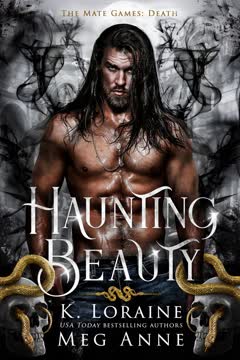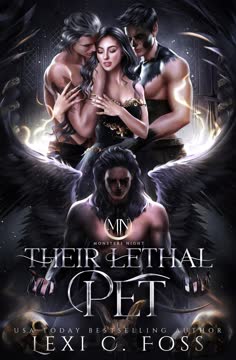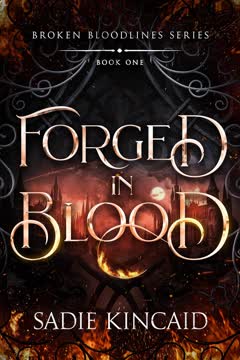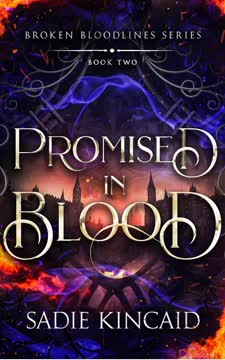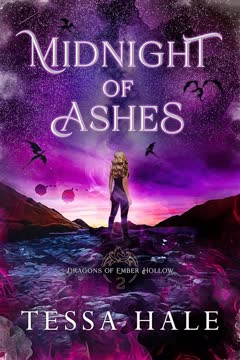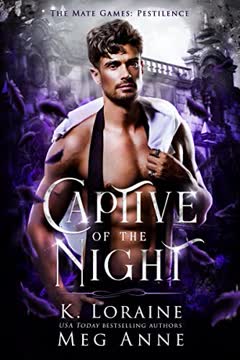Plot Summary
Shadows and Session Transcripts
The story opens with session transcripts and clinical observations, setting the tone for Blackwood—a supernatural asylum where nothing is as it seems. Dr. Temperance and Dr. Masterson discuss their patients, each with unique powers and traumas. The transcripts reveal a web of manipulation, hidden motives, and the ever-present threat of violence. The staff's flirtations and power plays mirror the chaos among the residents. The narrative's clinical detachment is pierced by moments of raw emotion, hinting at the deep wounds and desires that drive the characters. The sense of being watched, analyzed, and controlled pervades, foreshadowing the struggle for autonomy and truth that will define the story.
Hades Finds His Persephone
Hades, disguised as Cain, finally locates his long-lost soulmate, Dahlia, in a Los Angeles hospital. His obsession is palpable—he will do anything to reclaim her, even if it means violence. The reunion is fraught: Dahlia doesn't remember their past lives, and Hades' love is tangled with grief and possessiveness. Their connection is electric but haunted by reincarnation's curse. Hades' power and rage threaten to consume everyone around him, yet his vulnerability is exposed in Dahlia's presence. The chapter pulses with longing, confusion, and the ache of love that transcends lifetimes, setting the stage for a romance as dangerous as it is fated.
Dahlia's Tangled Heart
Dahlia, a writer with a haunted past, is caught between multiple supernatural suitors—Tor, Kai, Cain (Hades), and Caspian. Therapy sessions with Dr. Masterson reveal her confusion and longing. She questions her worth, her identity, and the nature of love when fate ties her to more than one mate. The men's claims on her are primal, but Dahlia's agency and doubts are central. She is both lost and found, torn between hope and fear, craving connection but terrified of being a replacement for someone else's lost love. The emotional stakes rise as she begins to accept her power and the reality of her bonds.
Therapy, Ghosts, and Gifts
Dahlia's therapy becomes a crucible for self-discovery. She learns her ability to see and control ghosts is evolving, and her connection to the supernatural world is deeper than she realized. A possessed doll, a mischievous spirit, and a test of her powers force Dahlia to confront her fears. The men in her life—Tor's beastly devotion, Kai's dragon fire, Caspian's pirate charm, and Hades' godly intensity—each bring out new facets of her magic and her heart. The chapter is a dance of vulnerability, humor, and terror, as Dahlia's world grows stranger and more dangerous.
Blood, Beasts, and Bonds
The men's rivalries erupt in blood and passion. Tor's berserker nature and Kai's dragon threaten to tear the group apart, but their shared love for Dahlia forces them into uneasy alliance. The boundaries between man and monster blur as they fight, hunt, and make love. Dahlia's acceptance of her polyamorous fate strengthens her powers, but also deepens the risks. The group's dynamic is volatile—jealousy, possessiveness, and the need for control clash with tenderness and loyalty. The emotional and physical stakes escalate, binding them together even as old wounds and new threats loom.
Pirate, Dragon, and Doll
Caspian's descent into madness is mirrored by the ticking of an invisible clock and the whispers of ghosts. The possessed doll becomes a symbol of the group's inability to escape their pasts and the supernatural forces at play. Dahlia's growing power is both a blessing and a curse, as she accidentally raises the dead and struggles to control her abilities. The men's attempts to protect her are both endearing and suffocating. The chapter is a whirlwind of humor, horror, and erotic tension, as the boundaries between sanity and madness, life and death, are tested.
Power Grows With Love
Each new bond Dahlia forms with her mates amplifies her supernatural abilities. The group discovers that their connections are not just emotional but magical, with each union unlocking new powers and dangers. The narrative explores the interplay of fate, choice, and destiny, as Dahlia's role as a medium and necromancer becomes clear. The men's own powers—Tor's control over his beast, Kai's dragon form, Hades' dominion over death, Caspian's fae magic—are all heightened by their love for her. The chapter is a celebration of chosen family, sexual liberation, and the transformative power of love.
The Haunted Rec Room
A succubus-induced orgy in the rec room spirals out of control, exposing the group's vulnerabilities and the dangers lurking within Blackwood. The aftermath is both comedic and chilling, as the residents grapple with the consequences and the ever-present threat of the Ripper—a serial killer targeting supernaturals. The group's unity is tested by external threats and internal insecurities. The haunted rec room becomes a microcosm of Blackwood itself: a place of pleasure, danger, and unresolved trauma. The chapter blends dark humor, eroticism, and suspense, as the group braces for the next attack.
Ghosts, Zombies, and Truth
Dahlia's powers reach new heights as she raises the dead—both ghosts and zombies—to uncover the truth behind the Ripper's murders. The group's investigation is fraught with peril, as they confront possessed bodies, vengeful spirits, and the limits of their own abilities. The narrative delves into the ethics of power, the cost of vengeance, and the trauma of survival. The truth about the Ripper is more complex and personal than anyone realized, forcing Dahlia and her mates to confront their own darkness. The chapter is a turning point, as secrets are revealed and the stakes become life and death.
Pirate's Madness, Dahlia's Power
Caspian's madness intensifies, threatening to tear him—and the group—apart. Dahlia's growing mastery over her powers is both a source of hope and a reminder of the dangers they face. The group's bonds are tested by jealousy, fear, and the ever-present threat of the Ripper. Therapy sessions, magical experiments, and erotic encounters become battlegrounds for control and trust. The chapter is a study in contrasts: madness and sanity, love and violence, power and vulnerability. The group's survival depends on their ability to accept themselves and each other, flaws and all.
The Four Become Five
The group's dynamic shifts as Caspian is fully accepted as a mate, completing the circle of love and power. The narrative explores the challenges and joys of polyamory, the importance of consent, and the healing power of chosen family. The group's unity is both their greatest strength and their greatest vulnerability, as external threats and internal demons converge. The chapter is a celebration of love in all its forms—romantic, platonic, sexual, and familial. The group's acceptance of each other is hard-won, but it gives them the strength to face the darkness ahead.
Reincarnation and Revelations
Hades' memories of past lives with Dahlia (his Persephone) come to the fore, complicating their relationship and raising questions about destiny and free will. The group grapples with the implications of reincarnation, soul bonds, and the cyclical nature of trauma and healing. Therapy sessions and magical rituals become vehicles for self-discovery and transformation. The narrative interrogates the meaning of identity, the possibility of change, and the power of memory. The chapter is both poignant and unsettling, as the group confronts the ghosts of their pasts and the uncertainty of their future.
The Ripper's Shadow
The Ripper's true identity is revealed in a harrowing sequence that sees Dahlia kidnapped, tortured, and forced to confront her deepest fears. The group's frantic search for her is a test of their love, loyalty, and power. The final confrontation is brutal and cathartic, as Kai's dragon form is unleashed and the Ripper is destroyed. The aftermath is a mix of relief, grief, and exhaustion. The group's victory is hard-won, but the scars—physical and emotional—remain. The chapter is a meditation on survival, justice, and the cost of violence.
Rituals, Wards, and Prison
The truth about Blackwood is revealed: it is not a sanctuary, but a prison, its residents bound by ancient spells and manipulations. Moira, the Belladonna witch, uncovers the compulsion runes that keep everyone trapped. The group's sense of agency is shattered, replaced by a determination to break free. Rituals and galas become battlegrounds for power and resistance. The narrative explores the tension between safety and autonomy, the ethics of control, and the possibility of rebellion. The chapter is a call to action, as the group vows to reclaim their freedom.
The Gala and the Graveyard
The annual gala brings together old friends, enemies, and family members, forcing the group to confront their pasts and their place in the supernatural world. Dahlia's kidnapping and near-sacrifice in the graveyard is the climax of the Ripper's reign of terror. The group's rescue mission is a testament to their love and power, but also a reminder of the dangers that still lurk in the shadows. The gala's glittering surface hides a web of secrets, betrayals, and unresolved trauma. The chapter is a study in contrasts: celebration and mourning, hope and despair, love and loss.
Death's Game Begins
In the aftermath of the Ripper's defeat, a new game begins. Death, revealed as Hel, manipulates events from the shadows, collecting the souls and powers of the horsemen—Chaos, Grim, Sin, and the yet-unrevealed Devil. The narrative shifts to a cosmic scale, as the group's struggles are revealed to be part of a larger, apocalyptic design. The boundaries between life and death, love and destruction, are blurred. The chapter is a chilling reminder that every victory comes at a cost, and that the true enemy may be closer than anyone realizes.
Apocalypse in the Shadows
The story ends with the group battered but unbroken, their love and unity the only bulwark against the darkness gathering on the horizon. The threat of the apocalypse looms, orchestrated by Hel and the horsemen, but the group's determination to fight for each other—and for their freedom—remains undimmed. The narrative is a meditation on resilience, hope, and the power of chosen family. The final image is one of defiance: even in the face of death and destruction, love endures.
Characters
Dahlia Moore
Dahlia is the emotional and magical center of the story—a woman marked by trauma, gifted with the ability to see and control ghosts, and fated to love more than one supernatural mate. Her journey is one of self-acceptance, as she learns to wield her powers and embrace her polyamorous destiny. Dahlia's relationships with Tor, Kai, Hades, and Caspian are complex, blending passion, vulnerability, and fierce loyalty. She is both a survivor and a healer, her empathy and strength drawing others to her. Dahlia's struggle with identity, worth, and agency is the heart of the narrative, and her growth is both inspiring and deeply human.
Hades (Cain Alexander)
Hades is a force of nature—powerful, possessive, and haunted by centuries of loss. His love for Dahlia (his reincarnated Persephone) is both his greatest strength and his deepest wound. Hades' struggle to balance his godly power with his human emotions is central to his arc. He is both protector and threat, his rage and grief threatening to consume everyone around him. Yet his vulnerability in Dahlia's presence reveals a longing for connection and redemption. Hades' journey is one of learning to let go, to trust, and to love without destroying.
Tor Nordson
Tor is a demigod cursed with a monstrous form and a violent past. His love for Dahlia is primal, possessive, and deeply protective. Tor's struggle to control his beast and find balance between man and monster is a recurring theme. His relationship with his twin, his rivalry with the other mates, and his fear of losing Dahlia drive much of the story's tension. Tor's arc is one of learning to share, to trust, and to accept love without fear. His vulnerability and loyalty make him both a fearsome warrior and a tender partner.
Malakai Nash (Kai)
Kai is torn between his duty to the Shadow Court and his love for Dahlia. His dragon is both a source of power and a threat to his humanity. Kai's journey is one of integration—learning to work with his dragon rather than against it, and to accept his place in the group. His Scottish heritage, his magical tattoos, and his struggle with control add depth to his character. Kai's love is steady, nurturing, and fiercely protective. His arc is one of self-acceptance, as he learns that vulnerability is not weakness.
Caspian Hook
Caspian is the wild card—charming, unpredictable, and teetering on the edge of madness. His past as a lost prince, his addiction to pixie dust, and his role as Captain Hook are both burdens and sources of strength. Caspian's love for Dahlia is obsessive, playful, and deeply loyal. His struggle with sanity, his rivalry with the other mates, and his need for purpose drive his arc. Caspian's journey is one of finding home and family, of learning that he is not alone, and that love can anchor even the most lost soul.
Dr. Elizabeth Masterson
Dr. Masterson is both guide and manipulator, her therapy sessions a crucible for the group's growth and a cover for deeper machinations. Her relationship with Dr. Temperance, her knowledge of magic, and her role in the rituals at Blackwood make her a pivotal figure. Masterson's motivations are complex—she genuinely cares for her patients, but is also complicit in the institution's secrets. Her arc is one of reckoning, as she is forced to confront the consequences of her actions and the limits of her power.
Dr. Nathaniel Temperance
Dr. Temperance is a master of manipulation, his clinical detachment masking a dangerous obsession. His true identity as the Ripper is a shocking revelation, and his role in the rituals and murders at Blackwood is central to the story's climax. Temperance's psychoanalysis reveals a man driven by envy, resentment, and a need for control. His downfall is both a victory and a warning—a reminder of the dangers of unchecked power and the cost of secrets.
Moira Belladonna
Moira is the Belladonna witch tasked with renewing Blackwood's wards. Her discovery of the compulsion runes and her decision to subvert the ritual make her a key ally. Moira's wit, courage, and loyalty are matched by her frustration at being manipulated by the High Council. Her arc is one of resistance, as she chooses to fight for freedom and justice, even at great personal risk.
Sorcha Blackthorne
Sorcha is both a source of comic relief and a reminder of the dangers lurking in Blackwood. Her family ties, her rivalry with other supernatural factions, and her own traumas add depth to her character. Sorcha's arc is one of survival and adaptation, as she navigates the shifting alliances and threats of the supernatural world.
Hel (Death)
Hel, revealed as Death, is the architect of the apocalypse and the true enemy lurking in the shadows. Her manipulation of the horsemen, her collection of souls, and her orchestration of events at Blackwood make her a formidable foe. Hel's motivations are both personal and cosmic—she seeks power, revenge, and the fulfillment of a destiny that threatens to consume the world. Her arc is one of escalation, as she moves from the shadows to the center stage, setting the stage for the next battle.
Plot Devices
Session Transcripts and Clinical Observation
The use of therapy session transcripts and clinical notes creates a sense of constant observation and manipulation. This device blurs the line between reality and performance, forcing characters to confront their own motives and traumas. It also allows for exposition, foreshadowing, and the gradual revelation of secrets. The transcripts serve as both a mirror and a mask, reflecting the characters' true selves while hiding the institution's darker purposes.
Reincarnation and Soul Bonds
The motif of reincarnation—especially Hades and Persephone's eternal love—infuses the narrative with a sense of destiny and inevitability. Soul bonds and mate marks are both blessings and curses, binding characters together across lifetimes and forcing them to confront unresolved wounds. This device allows for deep exploration of identity, agency, and the possibility of change. It also raises the stakes, as the characters' love is both their greatest strength and their greatest vulnerability.
Polyamory and Chosen Family
The group's polyamorous dynamic is both a source of power and a challenge to traditional narratives of romance and heroism. Their acceptance of each other—flaws, traumas, and all—creates a found family that is stronger than any individual. This device allows for exploration of consent, jealousy, and the healing power of community. It also serves as a bulwark against the forces of isolation, manipulation, and violence that threaten them.
Haunted Objects and Necromancy
The use of haunted dolls, spirit jars, and necromantic rituals grounds the supernatural elements in tangible, often terrifying, objects and actions. These devices force characters to confront the consequences of their power, the limits of control, and the cost of vengeance. The raising of the dead—both literal and metaphorical—serves as a metaphor for trauma, survival, and the struggle to reclaim agency.
Rituals, Wards, and Compulsion
The rituals and wards at Blackwood are both protective and imprisoning, reflecting the tension between safety and autonomy. The compulsion runes and the revelation of Blackwood as a prison force characters to question the nature of power, consent, and justice. This device allows for exploration of rebellion, resistance, and the ethics of care.
Foreshadowing and Cosmic Stakes
The gradual revelation of Hel's manipulation, the collection of the horsemen, and the looming threat of the apocalypse raise the stakes from personal survival to cosmic conflict. Foreshadowing is woven throughout the narrative, with hints of larger battles and deeper secrets. This device situates the characters' struggles within a larger, mythic framework, making their victories and losses resonate on a grand scale.
Analysis
Hateful Prince is a lush, darkly humorous, and emotionally charged reimagining of the supernatural romance, blending gothic horror, polyamorous love, and cosmic stakes. At its core, the novel is a meditation on trauma—how it shapes, wounds, and ultimately transforms us. The characters' struggles with identity, power, and agency are both deeply personal and universally resonant. The use of therapy, haunted objects, and rituals grounds the supernatural in the psychological, making the story as much about healing as it is about magic. The polyamorous dynamic is not just a source of erotic tension, but a radical act of resistance against isolation, manipulation, and violence. Love—messy, flawed, and fiercely loyal—is the only force strong enough to challenge the darkness, whether it comes from within or without. The novel's structure, with its session transcripts, shifting perspectives, and cosmic foreshadowing, invites readers to question the nature of reality, the ethics of power, and the possibility of redemption. In the end, Hateful Prince is a story about the courage to choose love, even when the world is ending.
Last updated:
Review Summary
Hateful Prince is the third book in The Mate Games: Death series by K. Loraine and Meg Anne. Readers praise the character development, plot twists, and steamy romance between Dahlia and her four paranormal mates. The full-cast audiobook narration receives high marks. Many reviewers appreciate the humor and crossover appearances from other series characters. While some criticize the pacing and repetitive elements, most fans eagerly anticipate the final installment. The book ends on a cliffhanger that leaves readers excited for the conclusion.
The Mate Games: Death Series
Similar Books
Download PDF
Download EPUB
.epub digital book format is ideal for reading ebooks on phones, tablets, and e-readers.

